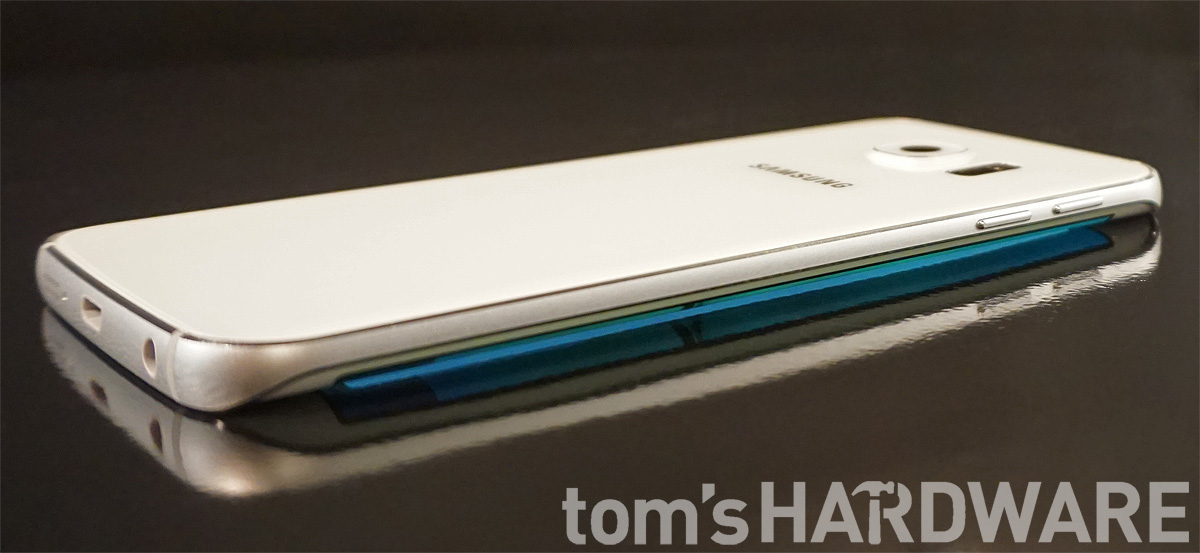Samsung Galaxy S 6 Preview
Galaxy S 6: Hardware And Software
Charging the new Galaxy phones is even easier and faster than before. For starters, the wonky USB 3.0 connector is gone, replaced by a standard microUSB 2.0 port, making it much easier to find a spare cable. It’s unlikely you’ll even need one though with integrated wireless charging built in, no extra accessories required. Supporting both major charging standards, WPC (Qi) and PMA, you can get about a 20% charge over a quick 20 to 30 minute lunch break. Plugging it into a power outlet will get you about 50% charge over the same time period, 30% faster than the S5, with the improved fast charging feature.
| Products | Samsung Galaxy S 6 | Samsung Galaxy S 6 edge | Samsung Galaxy S5 |
|---|---|---|---|
| SoC | Samsung Exynos 7420 (assumed) | Samsung Exynos 7420 (assumed) | Qualcomm Snapdragon 801 (MSM8974AC) |
| CPU Core | 4x ARM Cortex-A57 @ 2.1GHz + 4x ARM Cortex-A53 @ 1.5GHz (big.LITTLE) | 4x ARM Cortex-A57 @ 2.1GHz + 4x ARM Cortex-A53 @ 1.5GHz (big.LITTLE) | Qualcomm Krait 400 (4 Core) @ 2.45 GHz |
| GPU Core | ARM Mali-T760 (assumed) | ARM Mali-T760 (assumed) | Qualcomm Adreno 330 (32 ALU) @ 578 MHz |
| Memory | 3 GB LPDDR4 | 3 GB LPDDR4 | 2 GB LPDDR3 |
| Display | 5.1-inch SAMOLED @ 2560x1440 (577 PPI) | 5.1-inch SAMOLED @ 2560x1440 (577 PPI) | 5.1-inch SAMOLED @ 1920x1080 (432 PPI) |
| Storage | 32 GB, 64 GB, 128 GB | 32 GB, 64 GB, 128 GB | 16 GB, 32 GB, microSD (up to 128 GB) |
| Battery | 2,550 mAh (Non-Removable) | 2,600 mAh (Non-Removable) | 10.78 Whr (3.85V 2800 mAh, Removable) |
| Cameras | Front: 5 MP f1.9, automatic HDRRear: 16 MP f1.9, OIS, automatic HDR, object tracking autofocus, LED flash | Front: 5 MP f1.9, automatic HDRRear: 16 MP f1.9, OIS, automatic HDR, object tracking autofocus, LED flash | Front: 2 MPRear: 16 MP 1/2.6" CMOS, 1.12μm pixels, PDAF, HDR, LED flash |
| Connectivity | Wi-Fi 802.11a/b/g/n/ac (2x2 MIMO, 2.4GHz and 5GHz), Bluetooth 4.1 LE, NFC, IrLED, 4G LTE (Cat 6), microUSB 2.0 | Wi-Fi 802.11a/b/g/n/ac (2x2 MIMO, 2.4GHz and 5GHz), Bluetooth 4.1 LE, NFC, IrLED, 4G LTE (Cat 6), microUSB 2.0 | Wi-Fi 802.11a/b/g/n/ac (2x2 MIMO, 2.4GHz and 5GHz), Bluetooth 4.0 LE, NFC, IrLED, 4G LTE (Cat 4), Micro USB 3.0 |
| Special Features | Samsung KNOX, Samsung Pay, Quick Launch camera, wireless charging (WPC 1.1 & PMA 1.0), capacitive fingerprint sensor, support for Samsung Gear VR Innovator Edition | Samsung KNOX, Samsung Pay, Quick Launch camera, wireless charging (WPC 1.1 & PMA 1.0), capacitive fingerprint sensor, support for Samsung Gear VR Innovator Edition | IP67, Samsung KNOX, swipe-style capacitive fingerprint sensor |
| Size | 143.4 x 70.5 x 6.8mm, 138g | 142.1 x 70.1 x 7.0mm, 132g | 142.0 x 72.5 x 8.1 mm, 145 g |
This new, sleeker design and the inclusion of wireless charging necessitates some sacrifices however. Since the back panel is no longer removable, neither is the battery, which sees its capacity drop from 2800mAh for the S5 to 2,550mAh for the S 6 (2,600mAh for S 6 edge) due to the reduction in thickness. Unless efficiency is improved elsewhere, the smaller battery, combined with the brighter display and Android Lollipop’s heavy use of white backgrounds, could lead to a regression in battery life compared to the S5.
SD card support, another longstanding Galaxy feature, also gets ejected from the S 6. To make up for this loss, Samsung increases the internal storage, providing options for 32GB, 64GB, and 128GB of NAND and also throws in 115GB of complimentary storage space on Microsoft OneDrive for two years. Most people will find their storage needs satisfied given these options, but some will undoubtedly lament the loss in flexibility afforded by a removable storage solution.
Internal storage performance should also see a nice increase thanks to Samsung’s new UFS 2.0 NAND. UFS, a serial interface that employs command queuing, looks to supplant the currently used eMMC standard (at least in flagship devices), which uses an 8-bit parallel interface whose controller must execute commands in the order it receives them. Samsung claims performance numbers of 350 MB/s sequential read and 150 MB/s sequential write—a 1.4x-1.7x improvement in sequential performance over the eMMC 5.0 standard—along with 19,000 IO/s random read and 14,000 IO/s random write.
Last year the S5 inherited the IP67 dust and water resistance feature from the Galaxy Active line. Unfortunately, it doesn't stick around for the S 6. The Sony Xperia phones are IP67 rated and use a similar metal and glass construction, so perhaps we'll see a Galaxy S 6 Active version that reincorporates environmental protection in the future.
One feature that did not get cut is biometric authentication. The swipe-style fingerprint scanner that Samsung used on the S5 suffered from poor accuracy and frustrating false negatives when it debuted, and although subsequent software upgrades improved its usefulness significantly, it never matched Apple's Touch ID in performance or ease of use. For the S 6, Samsung swaps the swipe capacitive sensor for a touch-based one. Performance remains a mystery, but this new sensor will be much easier to use, requiring you to only place your finger on the sensor rather than perform an awkward swipe motion.
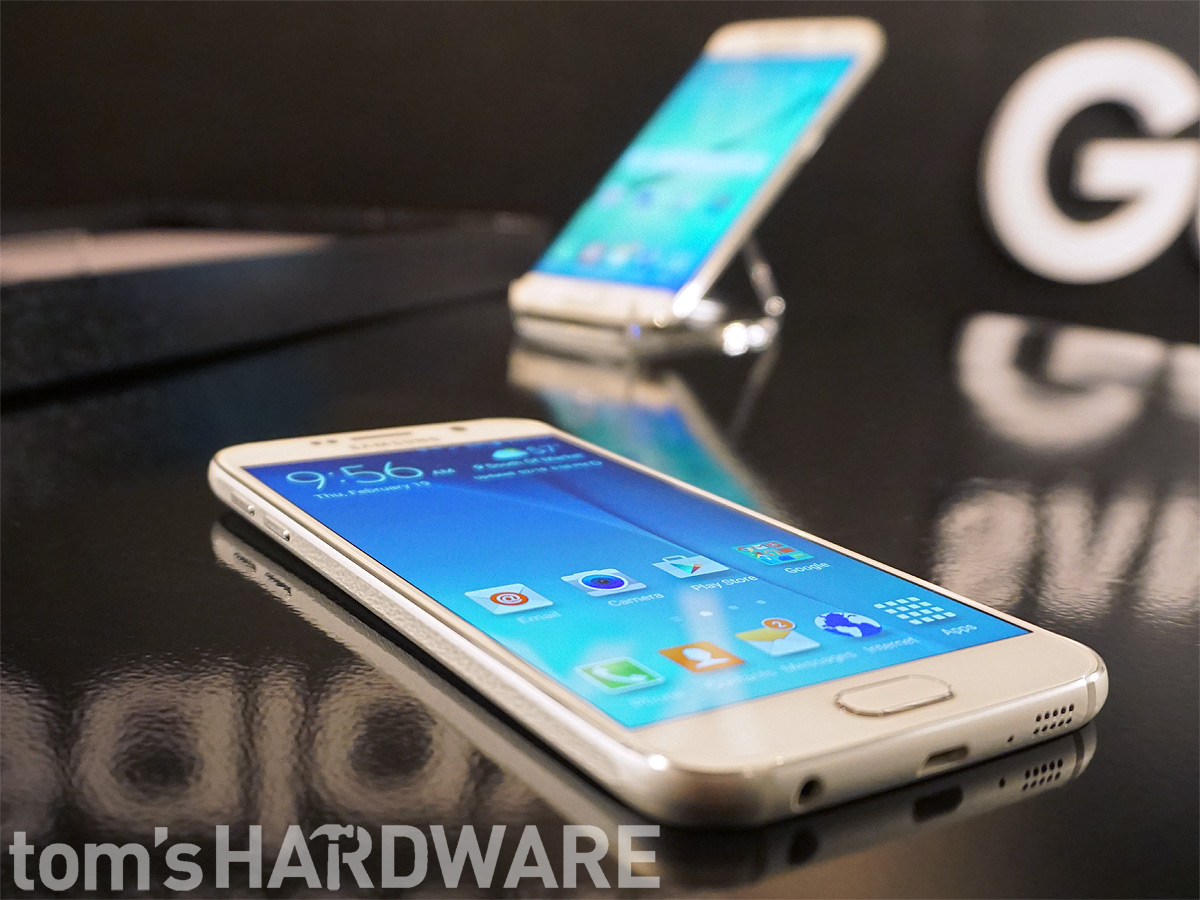
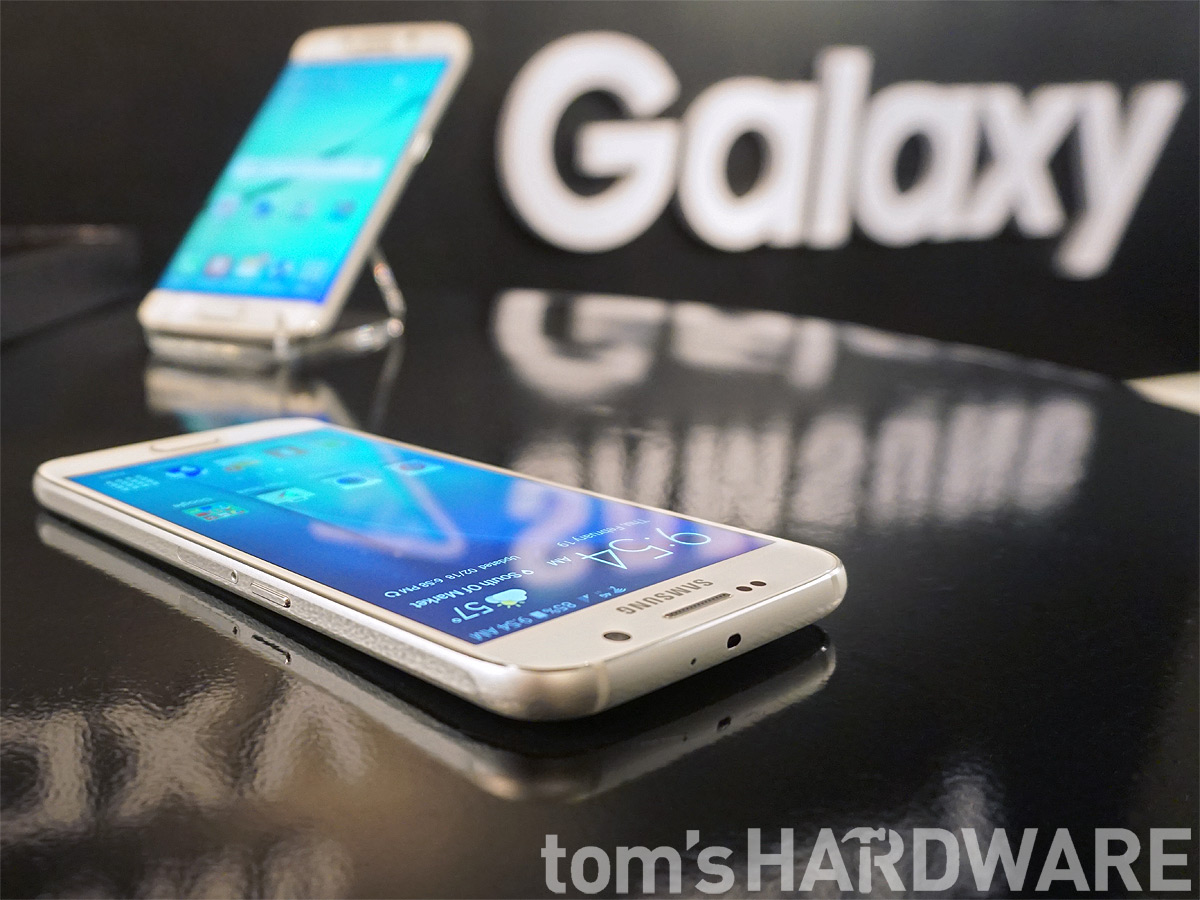

Full-Size Images: [Galaxy S 6 - bottom], [Galaxy S 6 - top], [Galaxy S 6 camera]
Get Tom's Hardware's best news and in-depth reviews, straight to your inbox.
Turning our attention to what's sandwiched between the two shiny glass sheets, we find what is likely an Exynos 7420 SoC (Samsung hasn’t divulged the specific name yet), which is significant for a couple of reasons. For starters, the S 6 will be the first Samsung device to use an Exynos chip exclusively for all SKUs—rather than its homegrown silicon appearing in only region specific variants—indicating that Exynos is ready to compete on a global scale. Second, the 7420 wins the race to 14nm, being the first SoC to use Samsung's latest FinFET process node. This should give the 7420 and the S 6 a power efficiency advantage over the Snapdragon 810, which is manufactured on TSMC's 20nm HKMG planar process, and any devices using it.
Like the Snapdragon 810, the Exynos 7420 uses four ARM Cortex-A57 and four Cortex-A53 CPUs in a heterogeneous big.LITTLE configuration, where all eight cores are available to the OS scheduler. With clock frequencies set to 2.1GHz for the A57s and 1.5GHz for the A53s, the S 6 should be the top performer of this flagship generation in CPU bound tasks, on paper at least. The accuracy of this statement however depends on several things. Can the 7420 maintain peak frequencies without throttling? Has Samsung tuned the S 6 to favor battery life over performance by governing CPU speed? How effectively will the S 6 utilize all eight cores? These questions won't be answered until we get an S 6 in our lab for testing though.
Sharing the same die as the ARM CPU cores is an ARM Mali-T760 GPU (again assuming the Exynos 7420 is the correct SoC). While the T760 will offer decent performance, it falls shy of the Adreno 430 in Snapdragon 810.
The S 6's Exynos SoC is paired with 3GB of high-speed LPDDR4 RAM, comparable to past and present flagship phones like the Sony Z3 and LG G Flex 2. Considering its newness and price premium, it's unlikely we'll see devices shipping with 4GB of LPDDR4 until late 2015 or early 2016.

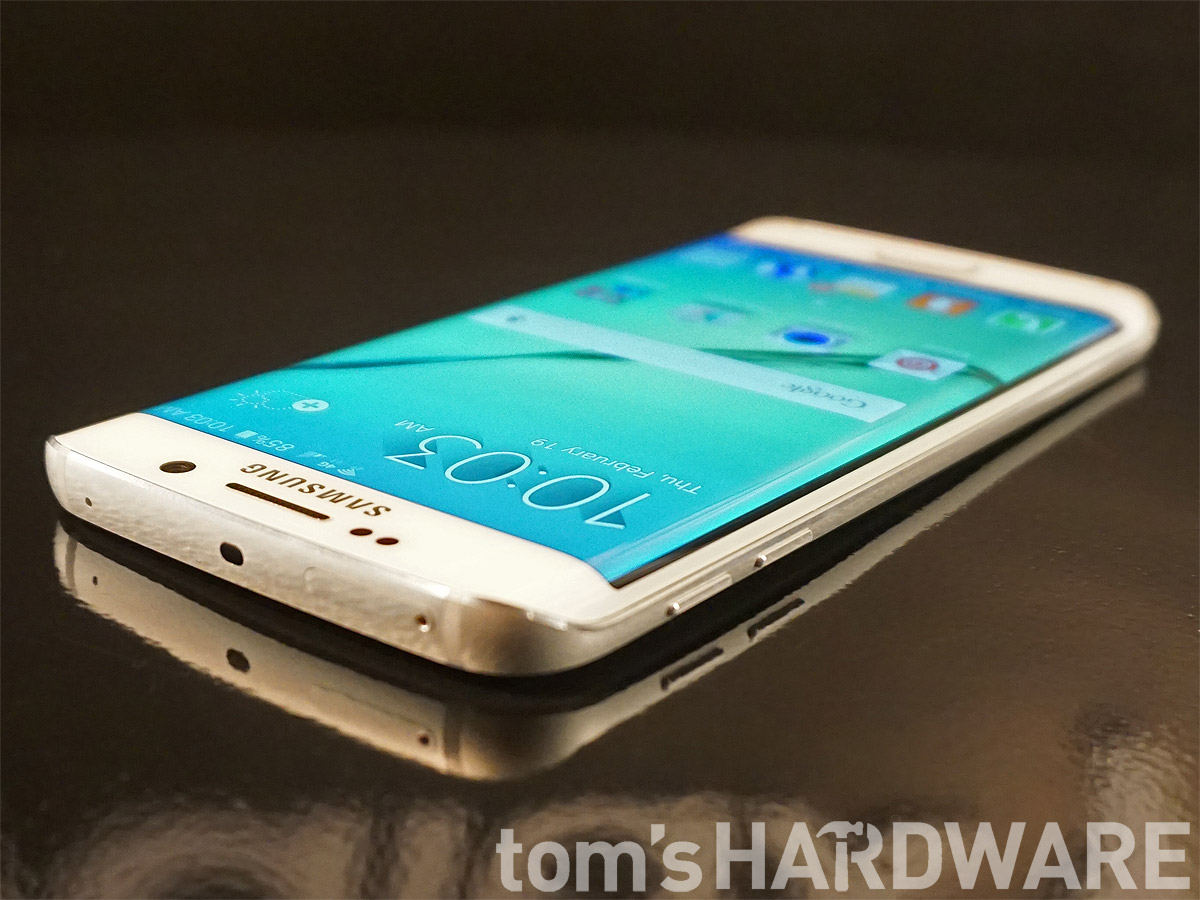
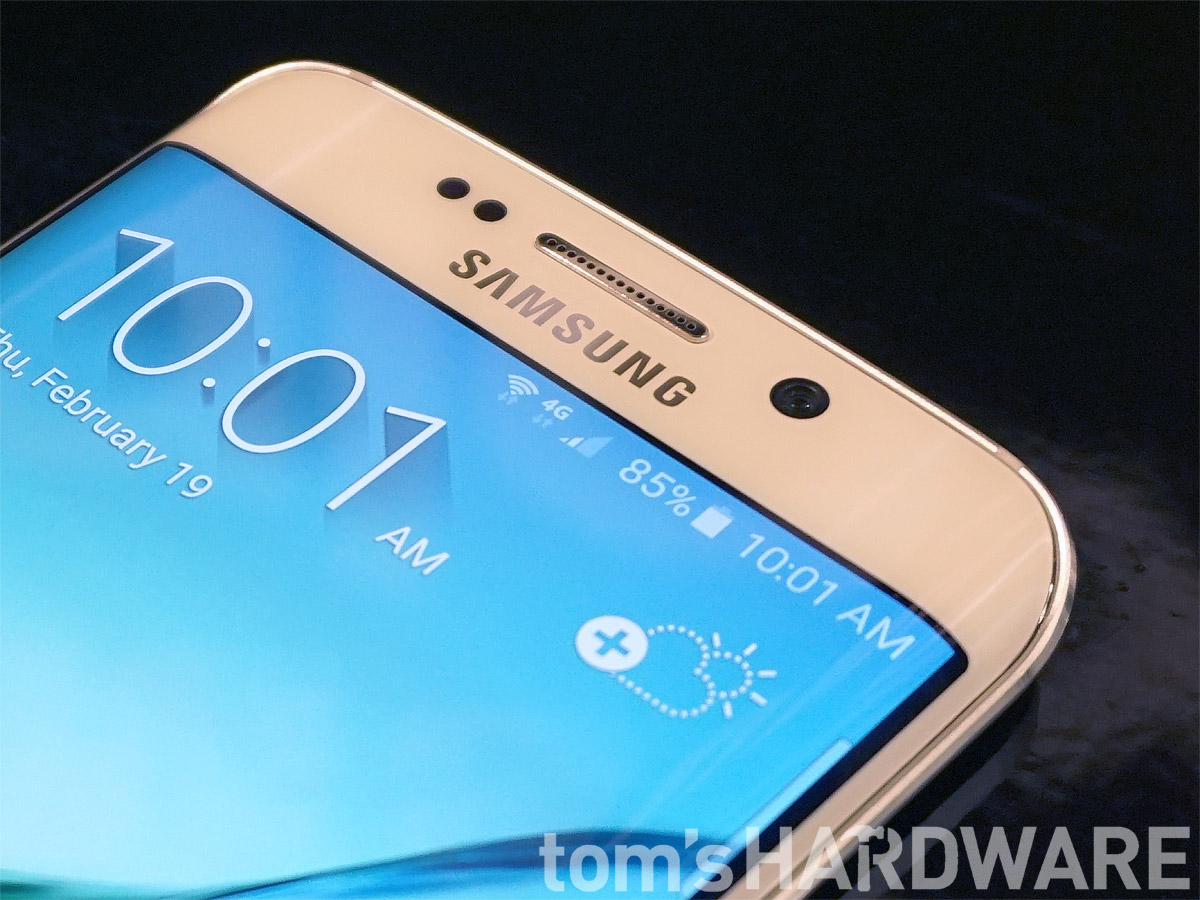
Full-Size Images: [Galaxy S 6 edge - bottom], [Galaxy S 6 edge - top], [Galaxy S 6 edge - front camera]
The S 6 comes with all the requisite radios, offering 802.11a/b/g/n/ac 2x2 MIMO Wi-Fi with speeds up to 620Mbps. There’s also support for Bluetooth 4.1 LE, NFC, and IrLED. The onboard modem, which is likely to be the Exynos Modem 300 with Exynos RF transceiver IC, supports multiple bands of 2G/3G/4G and LTE Cat 6, which uses carrier aggregation for downlink and uplink speeds up to 300/50Mbps.
NFC is one of the technologies used by Samsung Pay, its new mobile payment solution that can potentially be used at roughly 30 million locations worldwide. The greater acceptance is a result of Samsung’s recent acquisition of LoopPay, a company that developed a technology called Magnetic Secure Transmission (MST), which allows wireless payment transactions by simply holding the phone next to a traditional magnetic stripe credit card terminal. Similar to Apple Pay, Samsung’s payment solution tokenizes transactions and doesn’t store actual account numbers on the device. It also sounds simple to use: enroll a card, swipe up from the bezel to open the Samsung Pay app, select which card to use, tap the phone to the point-of-sale terminal, and authenticate the transaction with the fingerprint sensor. While the necessary hardware is already present, MST support won’t be fully enabled in the United States and Korea until a software update arrives sometime this summer. The service will be expanded to other regions sometime later.
Both of the cameras also receive upgrades. The front camera is 5MP, while the rear camera uses a 16MP sensor with optical image stabilization (OIS) and automatic, IR sensor-assisted white balance adjustment. It also employs object tracking autofocus that maintains focus lock on a moving object. Both front and rear cameras support automatic, real-time HDR and use optics with a F1.9 aperture to allow more light to hit the sensors.
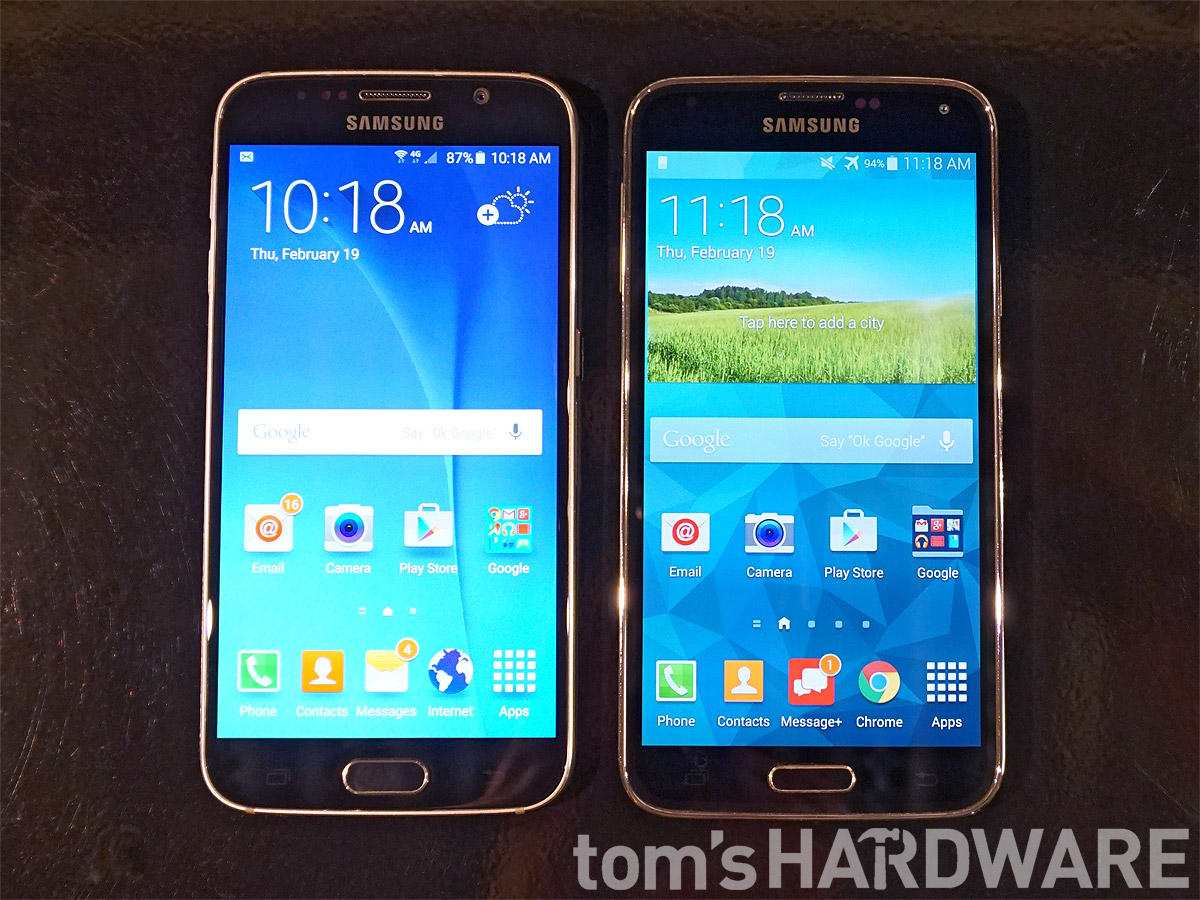

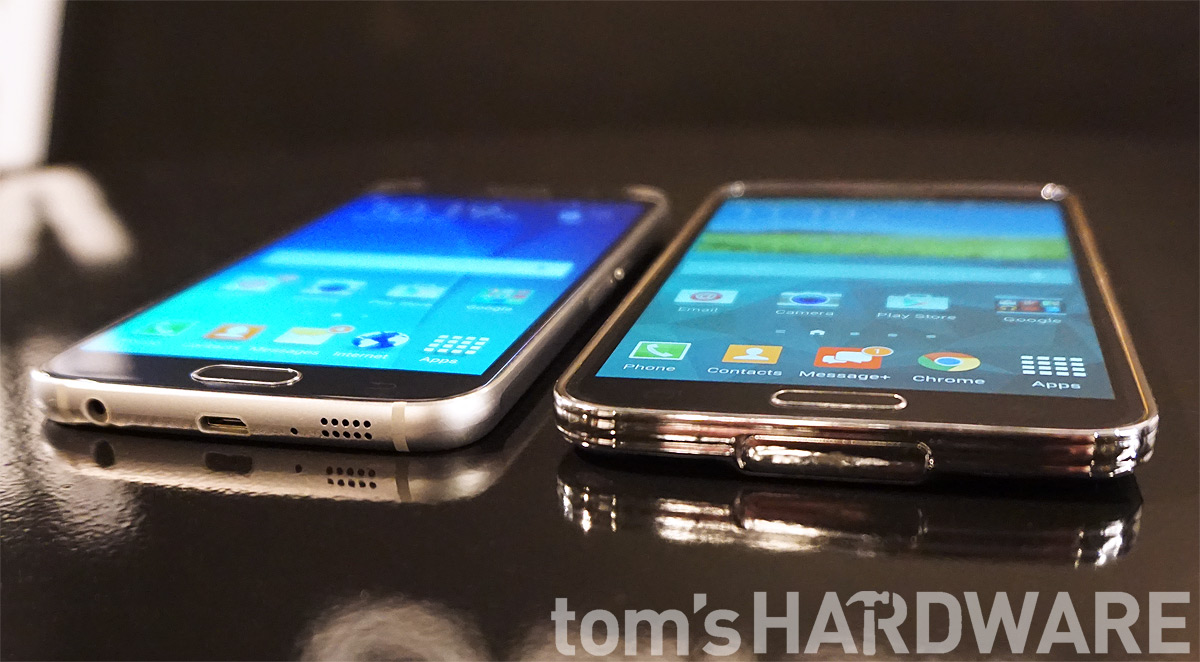
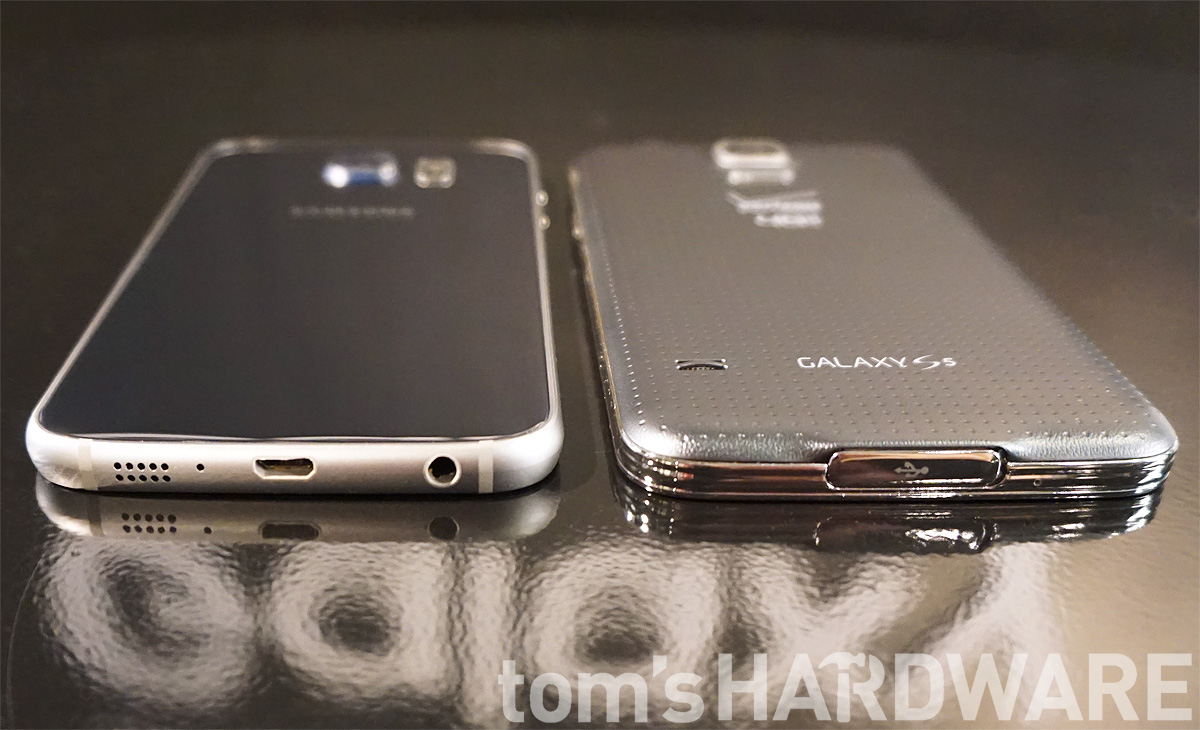
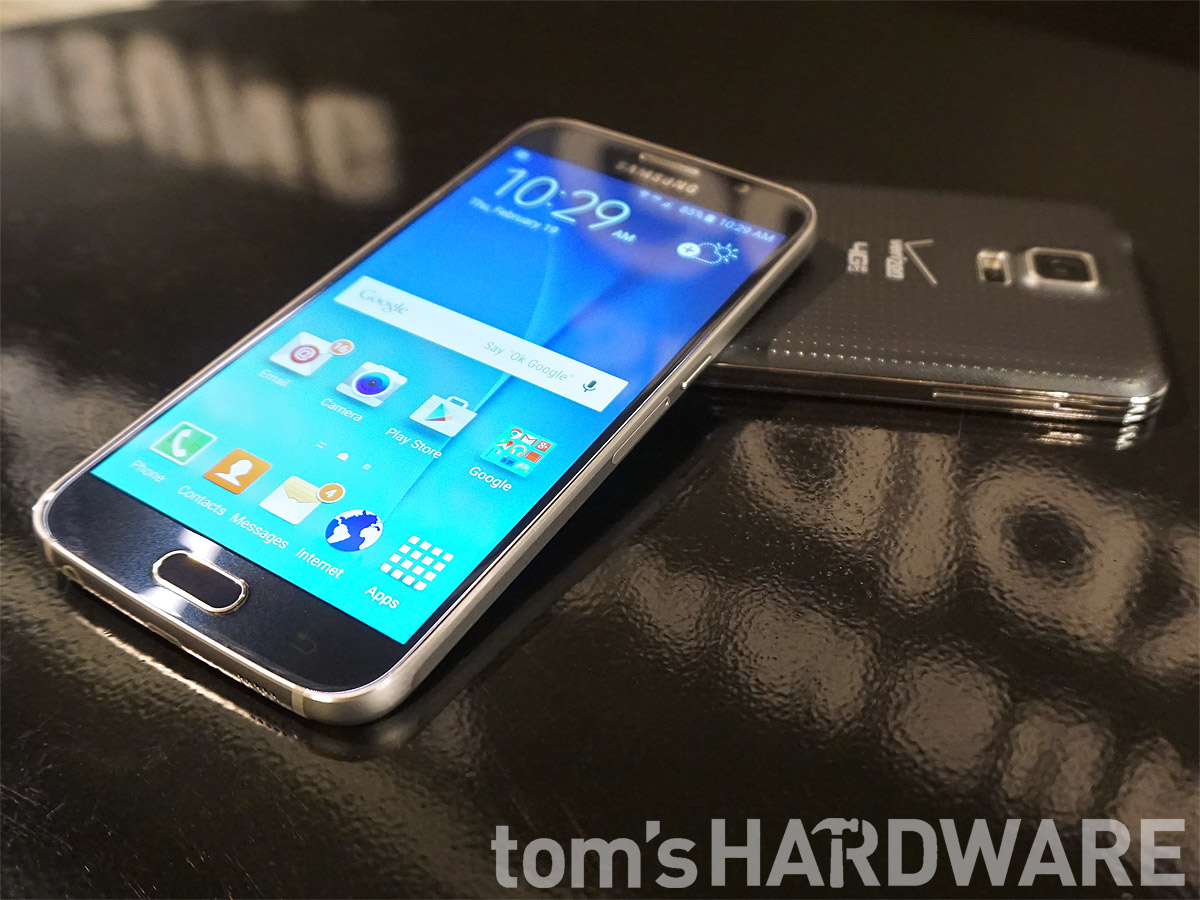
Full-Size Images: [Galaxy S 6 vs. S5 - front], [Galaxy S 6 vs. S5 - back], [Galaxy S 6 vs. S5 - detail 1], [Galaxy S 6 vs. S5 - detail 2], [Galaxy S 6 vs. S5 - detail 3]
As for software, the S 6s will ship with Android Lollipop and a new version of Samsung's TouchWiz UI, with a fresh new look of its own. Strongly adhering to Google's material design philosophy, the new TouchWiz makes better use of color for visual cues and swaps dark backgrounds for light. This last design change will reduce battery life somewhat, since AMOLED displays use more power when displaying white than black.
The interface is also much less cluttered, with emphasis placed on simplicity and efficiency. Icons have been replaced with descriptive text and often used controls have been placed within easy reach. Camera access is also improved with the new Quick Launch feature, which opens the camera app in less than one second after double-tapping the home button either from the lock screen or from within any app.
The S 6 edge's curves aren't just eye candy, but bring additional functionality like its big brother, the Note 4 Edge. Some of these features, along with the aforementioned visual changes, can be seen in the video below.
By placing an emphasis on design and simplicity instead of a lengthy list of sometimes poorly implemented features, the S 6 and S 6 edge are a refreshing addition to the Galaxy line and exactly what Samsung needs to remain competitive in the premium tier. The absence of microSD card support and a removable battery will deter some Galaxy fans, but the attractive new design, what should be excellent performance, and convenience features like wireless charging, Samsung Pay, biometric authentication, and the Quick Launch camera, increase the S 6's appeal and should attract new buyers.
Samsung says that both S 6 models will be available globally on April 10, 2015, although pricing was not specified.
-
Eddie Riggs Still using a Samsung Stratosphere. Even replaced it with another Stratosphere when the original one failed after 2 years of use. This S4, S5, and now this S6 doesn't really do anything that I need that my Stratosphere wont do. I'm sure it's a fast phone that can tell your heart rate and what the barometric pressure is in your general vicinity, but basically these phones are just becoming a way for the govt. to collect data in places where they couldn't get to before. Seriously! Who is using the barometer in a cell phone? Unless you have disposable income and just like to throw money away on every one of the latest gadgets to come out, buying the latest phone every year is pointless. So for those of you who can't wait to get the S6 so that your friends will be envious, you wont have to wait much longer! Oh yeah!Reply -
firefoxx04 Wow.. that intro tho. I use the S5 as my daily and its fantastic. Sounds like someone is just a little bias. Every review I read showed the S5 being par or better than most phones.Reply
Have fun with your fixed battery and no SD card support. Meanwhile im sitting here with a battery I can replace in a year or two if it craps along with a cheep 128GB removable storage.
I think the S6 is also lacking in the looks department along with a smaller battery. -
dstarr3 Replynon-replaceable batter + no sd card = not for me.
I generally agree about the battery, but when I think about it, I've made that a priority for my past three Samsung phones, which have lasted me six years, and not once have I had any battery issues. So, I guess it might be time to accept that it's fine.
But SD card, I agree. They're offering 128GB phones, which is a step in the right direction, but not if it costs an arm and a leg. -
-Fran- Reply15397764 said:I generally agree about the battery, but when I think about it, I've made that a priority for my past three Samsung phones, which have lasted me six years, and not once have I had any battery issues. So, I guess it might be time to accept that it's fine.
But SD card, I agree. They're offering 128GB phones, which is a step in the right direction, but not if it costs an arm and a leg.
I've seen a lot of friends having their batteries die on them in one or two years, so it is a big deal. Weather conditions affect *a lot* the batteries: humidity and heat. It's a risky thing they didn't make it as usual, but I can also understand they want to simplify things a bit. Same goes for the SD card slot. If the 128GB version is not stupid expensive, it won't be a deal breaker for me at least. I'm still debating on battery though, but just like you, I haven't had any issues with mine (S2 from 2010 and still working). My GF had a lot of issues with hers and her already dead Note 1. So far so good with the Note 3 for her.
Cheers! -
microFarads In my family we have 4 Samsungs: four S3 and one S4. All had their batteries dead and exchanged after 1 and a half years average. All have full capacity SD cards. We liked them all even though the S3 is damn slow and poor camera. I waited for the S6. we were Samsung loyals, but no more. We are looking for another brand. Pity...Reply -
Durandul I think they really missed an opportunity to wait and go with USB type C. That coupled with no expandable storage and a non removable battery, seems like a waste.Reply -
danawesome89 In response to the criticism of the s5:Reply
"Lacking in both innovative hardware and design, it failed to differentiate itself from other flagship phones"
Actually, it DID have a differentiating feature- it had a removable battery and SD card support. Those were the ONLY reasons my wife bought one over the similarly specced and priced competition. The s6 has removed these standout features. -
Sakkura Reply15397640 said:non-replaceable batter + no sd card = not for me.
It's one thing that the battery is non-replaceable. But it's another when the battery is also worse than in the last generation, AND the phone has a higher-res screen that will draw more power on its own as well as force the GPU to consume more power to render all those pixels. Samsung made a huge mistake here, destroying battery life and leaving no option for people to band-aid it with a battery upgrade.
